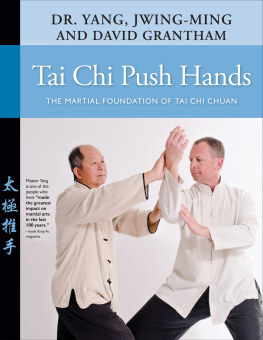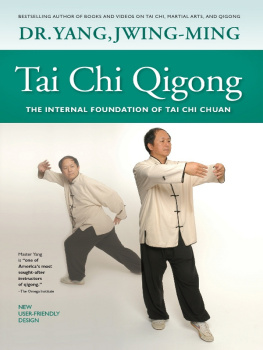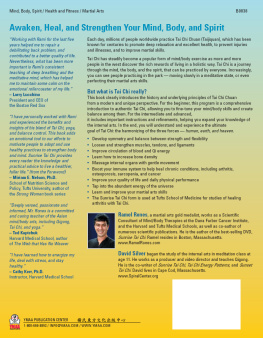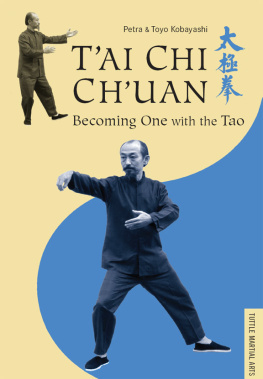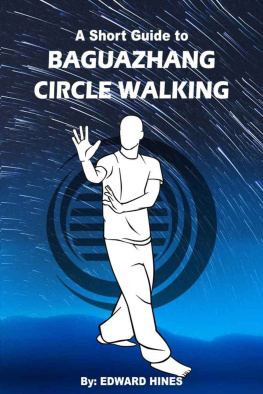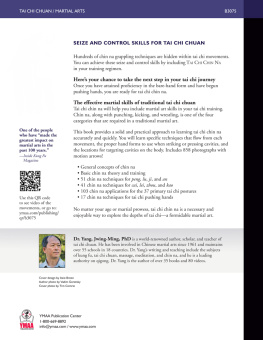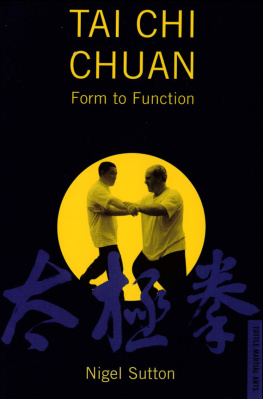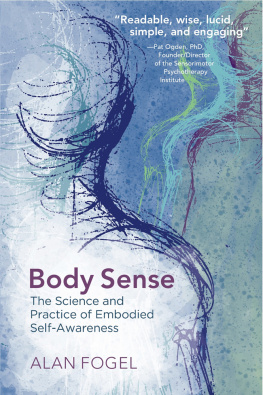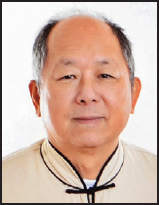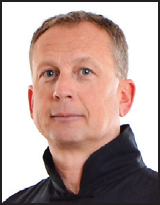Table of Contents
Page List
Guide
TAI CHI CHUAN / MARTIAL ARTS | B6458 |
PUSH HANDS IS WHAT MAKES YOUR TAI CHI PRACTICE A TRUE LIVING ART
Tai chi (taiji) push hands practice is necessary for tai chi practitioners who wish to make their art come alive. Push hands practice requires two people engaging in a variety of light touch stationary and moving routines. Practicing these movements allows practitioners to develop tai chis sensing, listening, and yielding skills. Combined, these skills are the first step for developing tai chi as a martial art.
Tai chi chuan (taijiquan) was created based on the martial applications, which were used for self-defense. Every movement of tai chi chuan has its unique martial purpose. Dr. Yang
The Dao De Jing classic reminds us that in order to know ourselves, we must first know others (our opponents).
By developing tai chi push hands skills, we can begin to cultivate a profound sense of feeling of our body and mind. These skills can help us to better control our body, balance, health, perseverance, compassion, and overall spirit.
In this book, you will learn
The theory of tai chi push hands
Tai chi qigong foundation practice
Tai chi jing (power) practice
Two-person stationary push hands practice
Two-person moving push hands practice
Tai chi rollback-and-press push hands practice
International standard push hands routine
Two-person free style push hands
Martial applications in push hands practice
Tai chi offers us a lifetime of learning and progress toward a deeper understanding of ourselves and our role in nature.
Yang, Jwing-Ming, PhD is a world-renowned author, scholar, and teacher. He has been involved in Chinese martial arts since 1961. Dr. Yangs writing and teaching include the subjects of kung fu, tai chi chuan, and meditation, and he is a leading authority on qigong. Dr. Yang is the author of over 35 books and 80 videos. Dr. Yang, Jwing-Ming resides in Miranda, California.
David Grantham is an author, a student of Dr. Yang, Jwing-Ming, and a certified instructor. Training martial arts since 1989, he is an airline pilot and teaches tai chi and qigong at the Hunterdon Health and Wellness Center in Clinton, New Jersey. David Grantham resides in Glen Gardner, New Jersey.
Cover design by Axie Breen
Photos by Tim Comrie
| YMAA Publication Center 1-800-669-8892 |
Tai Chi Push Hands
DAVID GRANTHAM DR. YANG, JWING-MING
Tai Chi Push Hands
THE MARTIAL FOUNDATION OF TAI CHI CHUAN
YMAA Publication Center, Inc.
Wolfeboro, NH USA
YMAA Publication Center, Inc.
PO Box 480
Wolfeboro, NH 03894
800 669-8892
ISBN: 9781594396458 (print) ISBN: 9781594396465 (ebook)
This book set in Adobe Garamond and Trade Gothic.
All rights reserved including the right of reproduction in whole or in part in any form.
Copyright 2020 by David Grantham and Dr. Yang, Jwing-Ming
Cover design by Axie Breen
Photos by YMAA Publication Center unless otherwise noted.
Illustration enhancements by Quentin Lopes
20201101
Publishers Cataloging in Publication
Names: | Yang, Jwing-Ming, 1946- author. | Grantham, David W., 1965- author. |
Title: Tai chi push hands : the martial foundation of tai chi chuan / Dr. Yang, Jwing-Ming and David Grantham. |
Other titles: | Title. |
Description: | Wolfeboro, NH USA YMAA Publication Center, Inc., [2020] | Series: True wellness. | Includes translation and glossary of Chinese terms. | Includes bibliographical references and index. |
Identifiers: | ISBN: 9781594396458 (print) | 9781594396465 (ebook) | LCCN: 2020943116 |
Subjects: | LCSH: Tai chi. | Martial arts--Training. | Hand-to-hand fighting, Oriental--Training. | Qi gong. | Qi (Chinese philosophy) | Laozi. Dao de jing. | Force and energy. | Vital force. | Martial arts--Health aspects. | Mind and body. | BISAC: HEALTH & FITNESS /Tai Chi. | HEALTH & FITNESS / Exercise / Stretching. | SPORTS & RECREATION / Martial Arts. | SPORTS & RECREATION / Health & Safety. |
Classification: | LCC: GV504 .Y366 2020 | DDC: 796.815/5--dc23 |
The authors and publisher of the material are NOT RESPONSIBLE in any manner whatsoever for any injury which may occur through reading or following the instructions in this manual.
The activities physical or otherwise, described in this manual may be too strenuous or dangerous for some people, and the reader(s) should consult a physician before engaging in them.
Neither the authors nor the publisher assumes any responsibility for the use or misuse of information contained in this book.
Nothing in this document constitutes a legal opinion nor should any of its contents be treated as such. While the authors believe that everything herein is accurate, any questions regarding specific self-defense situations, legal liability, and/or interpretation of federal, state, or local laws should always be addressed by an attorney at law.
When it comes to martial arts, self-defense, and related topics, no text, no matter how well written, can substitute for professional, hands-on instruction. These materials should be used for academic study only.
Editorial Notes
Romanization of Chinese Words
The interior of this book primarily uses the Pinyin romanization system of Chinese to English. In some instances, a more popular word may be used as an aid for reader convenience, such as tai chi in place of the Pinyin spelling, taiji. Pinyin is standard in the Peoples Republic of China and in several world organizations, including the United Nations. Pinyin, which was introduced in China in the 1950s, replaces the older Wade-Giles and Yale systems.
Some common conversions are found in the following:
Pinyin | Also spelled as | Pronunciation |
qi | chi | ch |
qigong | chi kung | ch gng |
qin na | chin na | chn n |
gongfu | kung fu | gng foo |
taijiquan | tai chi chuan | t j chn |
For more information, please refer to The Peoples Republic of China: Administrative Atlas, The Reform of the Chinese Written Language, or a contemporary manual of style.
Formats and Treatment of Chinese Words
Transliterations are provided frequently: for example, Five Animal Sport (Wu Qin Xi,
Chinese persons names are presented mostly in their more popular English spelling. Capitalization is according to the

